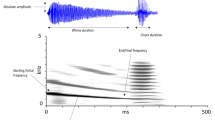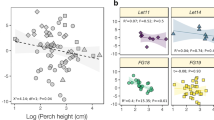Abstract
Variations in the costs or benefits of signaling may result in variations in signaling strategies. The adverse conditions hypothesis suggests that reliable signaling can be improved under stress or adverse environmental conditions, but the empirical cases are limited. In the present study, we manipulated food availability in male Xenopus laevis in order to determine whether certain characteristics of advertisement call in X. laevis are condition-dependent and how food depletion modulates the association between individual condition and signaling performance. The results showed that although frogs tend to decrease their within-bout call rate compared to other call characteristics (calling effort and dominant frequency) under food constraint, none of them was statistically significantly affected by food restriction. However, within-bout call rate was positively coupled with adaptive immunocompetence in starved frogs, and the correlation was decoupled in those with free access to food. These results support that within-bout call rate is a condition-dependent characteristic of advertisement call and even mild adverse conditions may enhance reliable signaling in X. laevis, probably due to enlarging the relative fitness difference between high- and low-condition individuals.


Similar content being viewed by others
References
Ahtiainen JJ, Alatalo RV, Kortet R, Rantala MJ (2004) Sexual advertisement and immune function in an arachnid species (Lycosidae). Behav Ecol 15:602–606
Andersson MB (1994) Sexual selection. Princeton University Press, Princeton
Brepson L, Voituron Y, Lengagne T (2013) Condition-dependent ways to manage acoustic signals under energetic constraint in a tree frog. Behav Ecol 24:488–496
Brown GP, Shilton CM, Shine R (2011) Measuring amphibian immunocompetence: validation of the phytohemagglutinin skin-swelling assay in the cane toad, Rhinella marina. Methods Ecol Evol 4:341–348
Burkhard TT, Westwick RR, Phelps SM (2018) Adiposity signals predict vocal effort in Alston’s singing mice. Proc R Soc B 285:20180090
Candolin U (1999) The relationship between signal quality and physical condition: is sexual signalling honest in the three-spined stickleback? Anim Behav 58:1261–1267
Candolin U (2000a) Changes in expression and honesty of sexual signalling over the reproductive lifetime of sticklebacks. P R Soc B 267:2425–2430
Candolin U (2000b) Male-male competition ensures honest signaling of male parental ability in the three-spined stickleback (Gasterosteus aculeatus). Behav Ecol Sociobiol 49:57–61
Cary TL, Ortiz-Santaliestra ME, Karasov WH (2014) Immunomodulation in post-metamorphic northern leopard frogs, Lithobates pipiens, following larval exposure to polybrominated diphenyl ether. Environ Sci Technol 48:5910–5919
Castellano S, Cermelli P (2010) Attractive amplifiers in sexual selection: where efficacy meets honesty. Evol Ecol 24:1187–1197
Cockburn A, Osmond HL, Double MC (2008) Swingin’ in the rain: condition dependence and sexual selection in a capricious world. P R Soc B 275:605–612
Cornwallis CK, Uller T (2010) Towards an evolutionary ecology of sexual traits. Trends Ecol Evol 25:145–152
Cothran RD, Jeyasingh PD (2010) Condition dependence of a sexually selected trait in a crustacean species complex: importance of the ecological context. Evolution 64:2535–2546
Cotton S, Fowler K, Pomiankowski A (2004) Do sexual ornaments demonstrate heightened condition-dependent expression as predicted by the handicap hypothesis? P R Soc B 271:771–783
Demas GE, Zysling DA, Beechler BR, Muehlenbein MP, French SS (2011) Beyond phytohaemagglutinin: assessing vertebrate immune function across ecological contexts. J Anim Ecol 80:710–730
Desprat JL, Lengagne T, Dumet A, Desouhant E, Mondy N (2015) Immunocompetence handicap hypothesis in tree frog: trade-off between sexual signals and immunity? Behav Ecol 26:1138–1146
Dittus WPJ (2013) Arboreal adaptations of body fat in wild toque macaques (Macaca sinica) and the evolution of adiposity in primates. Am J Phys Anthropol 152:333–344
Fites JS, Reinert LK, Chappell TM, Rollins-Smith LA (2014) Inhibition of local immune responses by the frog-killing fungus Batrachochytrium dendrobatidis. Infect Immun 82:4698–4706
Folstad I, Karter AJ (1992) Parasites, bright males, and the immunocompetence handicap. Am Nat 139:603–622
Gerhardt HC (1994) The evolution of vocalization in frogs and toads. Annu Rev Ecol Syst 25:293–324
Gilbertson MK, Haffner GD, Drouillard KG, Albert A, Dixon B (2003) Immunosuppression in the northern leopard frog (Rana pipiens) induced by pesticide exposure. Environ Toxicol Chem 22:101–110
Grafen A (1990) Biological signals as handicaps. J Theor Biol 144:517–546
Graham JL, Mady RP, Greives TJ (2017) Experimental immune activation using a mild antigen decreases reproductive success in free-living female dark-eyed juncos (Junco hyemalis). Can J Zool 95:263–269
Gustafsson L, Qvarnstrom A, Sheldon BC (1995) Trade-offs between life-history traits and a secondary sexual character in male collared flycatchers. Nature 375:311–313
Hamilton WD, Zuk M (1982) Heritable true fitness and bright birds—a role for parasites. Science 218:384–387
Harris JR, Markl J (1999) Keyhole limpet hemocyanin (KLH): a biomedical review. Micron 30:597–623
Hill GE (2011) Condition-dependent traits as signals of the functionality of vital cellular processes. Ecol Lett 14:625–634
Hunt J, Brooks R, Jennions MD, Smith MJ, Bentsen CL, Bussiere LF (2004) High-quality male field crickets invest heavily in sexual display but die young. Nature 432:1024–1027
Jasnow AM, Drazen DL, Huhman KL, Nelson RJ, Demas GE (2001) Acute and chronic social defeat suppresses humoral immunity of male Syrian hamsters (Mesocricetus auratus). Horm Behav 40:428–433
Johnstone RA (1995) Sexual selection, honest advertisement and the handicap principle: Reviewing the evidence. Biologic Rev 70(1):1–65
Koch RE, Josefson CC, Hill GE (2016) Mitochondrial function, ornamentation, and immunocompetence. Biol Rev 92:1459–1474
Madelaire CB, da Silva RJ, Gomes FR (2013) Calling behavior and parasite intensity in treefrogs, Hypsiboas prasinus. J Herpetol 47:450–455
Maniero GD, Morales H, Gantress J, Robert J (2006) Generation of a long-lasting, protective, and neutralizing antibody response to the ranavirus FV3 by the frog Xenopus. Dev Comp Immunol 30:649–657
Martin J, Civantos E, Amo L, Lopez P (2007) Chemical ornaments of male lizards Psammodromus algirus may reveal their parasite load and health state to females. Behav Ecol Sociobiol 62:173–179
Merkle S (1989) Long-term starvation in Xenopus laevis Daudin. 3. Effects on enzymes in several tissues. Comp Biochem Phys B 94:783–788
Merkle S, Hanke W (1988) Long-term starvation in Xenopus laevis Daudin. 1. Effects on general metabolism. Comp Biochem Phys B 89:719–730
Moller AP, Petrie M (2002) Condition dependence, multiple sexual signals, and immunocompetence in peacocks. Behav Ecol 13:248–253
Peig J, Green AJ (2010) The paradigm of body condition: a critical reappraisal of current methods based on mass and length. Funct Ecol 24:1323–1332
Rantala MJ, Kortet R, Kotiaho JS, Vainikka A, Suhonen J (2003) Condition dependence of pheromones and immune function in the grain beetle Tenebrio molitor. Funct Ecol 17:534–540
Robinson MR, Pilkington JG, Clutton-Brock TH, Pemberton JM, Kruuk LEB (2008) Environmental heterogeneity generates fluctuating selection on a secondary sexual trait. Curr Biol 18:751–757
Ryan MJ, Rand AS (1993) Sexual selection and signal evolution—the ghost of biases past. Philos T Roy Soc B 340:187–195
Ryder JJ (2000) Male calling song provides a reliable signal of immune function in a cricket. P R Soc B 267:1171–1175
Saks L, Ots I, Horak P (2003) Carotenoid-based plumage coloration of male greenfinches reflects health and immunocompetence. Oecologia 134:301–307
Tobias ML, Viswanathan SS, Kelley DB (1998) Rapping, a female receptive call, initiates male-female duets in the South African clawed frog. P Natl Acad Sci USA 95:1870–1875
Tobias ML, Corke A, Korsh J, Yin D, Kelley DB (2010) Vocal competition in male Xenopus laevis frogs. Behav Ecol Sociobiol 64:1791–1803
Tobias ML, Evans BJ, Kelley DB (2011) Evolution of advertisement calls in African clawed frogs. Behaviour 148:519–549
Tobias ML, Korsh J, Kelley DB (2014) Evolution of male and female release calls in African clawed frogs. Behaviour 151:1313–1334
Tolle AE, Wagner WE (2011) Costly signals in a field cricket can indicate high- or low-quality direct benefits depending upon the environment. Evolution 65:283–294
Vergara P, Martinez-Padilla J, Mougeot F, Leckie F, Redpath SM (2012) Environmental heterogeneity influences the reliability of secondary sexual traits as condition indicators. J Evolut Biol 25:20–28
Wetzel DM, Kelley DB (1983) Androgen and gonadotropin effects on male mate calls in South African clawed frogs, Xenopus laevis. Horm Behav 17:388–404
Xu DL, Wang DH (2010) Fasting suppresses T cell-mediated immunity in female Mongolian gerbils (Meriones unguiculatus). Comp Biochem Phys A 155:25–33
Xu F, Cui JG, Song J, Brauth SE, Tang YZ (2012) Male competition strategies change when information concerning female receptivity is available. Behav Ecol 23:307–312
Zahavi A (1975) Mate selection—selection for a handicap. J Theor Biol 53:205–214
Acknowledgement
We thank all the members of the Behavioral Neuroscience Group for their discussion and help with this study. We are grateful to Steven E. Brauth, The University of Maryland, for improving the English text. The study was conceived and designed by JFC and XCW. Experiments were performed by XCW, JFC, ZZJ and YC; results were analyzed and interpreted by JFC and XCW. The paper was written by JFC and XCW. This work was financially supported by grants from the National Natural Science Foundation of China (31370431) to JFC, (31270458) to ZZJ, and (31270042) to JGC.
Author information
Authors and Affiliations
Corresponding author
Ethics declarations
Conflict of interest
The authors declare that they have no conflict of interest.
Human and animal rights statement
This article does not contain any studies with human participants performed by any of the authors. All animal procedures in this study were carried out in accordance with and approved by the Animal Care and Use Committee at the Chengdu Institute of Biology, Chinese Academy of Sciences. All applicable international, national, and/or institutional guidelines for the care and use of animals were followed.
Electronic supplementary material
Below is the link to the electronic supplementary material.
About this article
Cite this article
Wang, X., Zhao, ZJ., Cao, Y. et al. Condition dependence of advertisement calls in male African clawed frogs. J Ethol 37, 75–81 (2019). https://doi.org/10.1007/s10164-018-0570-z
Received:
Accepted:
Published:
Issue Date:
DOI: https://doi.org/10.1007/s10164-018-0570-z




